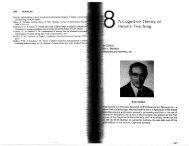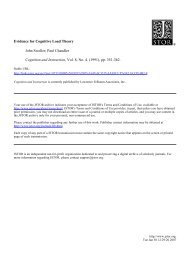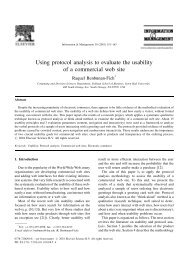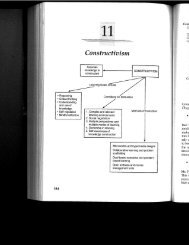a primer on verbal protocol analysis - Ammon Wiemers' Home Page
a primer on verbal protocol analysis - Ammon Wiemers' Home Page
a primer on verbal protocol analysis - Ammon Wiemers' Home Page
You also want an ePaper? Increase the reach of your titles
YUMPU automatically turns print PDFs into web optimized ePapers that Google loves.
C35165/Schmorrow <strong>Page</strong> 339<br />
A Primer <strong>on</strong> Verbal Protocol Analysis 339<br />
of this segmentati<strong>on</strong> scheme from the meteorology domain. As the illustrati<strong>on</strong><br />
shows, the length of each utterance can vary from a single word(s) (for example,<br />
“850”) to fairly lengthy (for example, “clouds are going to be increasing for the<br />
next 24 hours in western Ohio”). In this domain, we are generally interested in<br />
the types of mental operati<strong>on</strong> participants perform <strong>on</strong> the visualizati<strong>on</strong>s, such as<br />
reading off informati<strong>on</strong>, transforming informati<strong>on</strong> (spatially or otherwise), making<br />
comparis<strong>on</strong>s, and the like, and these map well to our segmentati<strong>on</strong> scheme.<br />
The utterances “it’s at 700 millibars” and “clouds are going to be increasing for<br />
the next 24 hours in western Ohio” would each be coded as <strong>on</strong>e “read-off informati<strong>on</strong>”<br />
event, even though they differ quite a bit in length. Of course, it would<br />
be possible to subdivide l<strong>on</strong>ger utterances further (for example, “clouds are going<br />
to be increasing // for the next 24 hours // in western Ohio”); however, according<br />
to our coding scheme this is still <strong>on</strong>e read-off informati<strong>on</strong> event, which would<br />
now span three utterances. Having a single event span more than <strong>on</strong>e utterance<br />
makes data <strong>analysis</strong> harder. The two most important guidelines in dividing <strong>protocol</strong>s<br />
are (1) c<strong>on</strong>sistency and (2) making sure that the segments map readily to the<br />
codes to be applied.<br />
Although transcripti<strong>on</strong> cannot be automated, a number of video <strong>analysis</strong> software<br />
programs are available to aid in data <strong>analysis</strong>, and some of these programs<br />
allow <strong>protocol</strong>s to be transcribed directly into the software. We have not found<br />
the perfect <strong>protocol</strong> <strong>analysis</strong> program yet, though we have used MacShapa,<br />
Transana, and Noldus Observer. Looking ahead and deciding what kind of <strong>analysis</strong><br />
software will be used will also save a great deal of time by reducing the need<br />
for further processing of transcripts in order to successfully import them to the<br />
video <strong>analysis</strong> software. Another opti<strong>on</strong> that we have successfully used is to transcribe<br />
<strong>protocol</strong>s in a spreadsheet program, such as Excel, with each segment <strong>on</strong> a<br />
different row. We then set up columns for our different coding categories and can<br />
easily perform frequency counts, create pivot tables, and import the data into a<br />
statistical <strong>analysis</strong> program. This method works very well if the video porti<strong>on</strong><br />
of the <strong>protocol</strong> is irrelevant; however, in most cases we are interested not <strong>on</strong>ly<br />
in what people are saying, but what they are doing (and looking at) while they<br />
are saying it. In this case, using the spreadsheet method is disadvantageous,<br />
because the transcripti<strong>on</strong> cannot easily be aligned with the video. Video <strong>analysis</strong><br />
software has the advantage that video timestamps are automatically entered at<br />
each line of transcripti<strong>on</strong>, thus facilitating synchr<strong>on</strong>izing text and video.<br />
Once data have been transcribed and segmented, they are ready for coding.<br />
Unless the research questi<strong>on</strong> can be answered by some kind of linguistic coding<br />
(for example, counting the number of times a certain word or family of words is<br />
used), a coding scheme must be developed that maps to the cognitive processes<br />
of interest. Establishing and implementing an effective and reliable coding<br />
scheme lies at the heart of <strong>verbal</strong> <strong>protocol</strong> <strong>analysis</strong>, and this is usually the most<br />
difficult and time c<strong>on</strong>suming part of the whole process. In some cases, researchers<br />
will have str<strong>on</strong>g a priori noti<strong>on</strong>s about what to look for. However, <strong>verbal</strong> <strong>protocol</strong><br />
<strong>analysis</strong> is a method that is particularly useful in exploratory research, and<br />
in these cases, researchers may approach the <strong>protocol</strong> with <strong>on</strong>ly a general idea.






